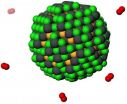(Press-News.org) St. Louis, Mo. (June 9, 2014) – Anti-androgen hormonal therapy, also called chemical castration, can be an important defense against further disease progression for patients with prostate cancer that has traveled and grown in other areas, or metastasized—but some cases simply do not respond to this treatment. A groundbreaking molecular imaging agent has been developed to help clinicians find as much cancer as possible, whether it is responding favorably or not, in an effort to improve clinical decision making for these patients, say researchers at the Society of Nuclear Medicine and Molecular Imaging's 2014 Annual Meeting.
The imaging technique championed by this study is called F-18 DCFBC PET/CT, developed at Johns Hopkins University in Baltimore, Md., by study co-author Martin G. Pomper, MD, PhD. F-18 DCFBC is a unique small-molecule PET agent that searches for and attaches to prostate-specific membrane antigen (PSMA), which signals more strongly from malignant prostate cells than from normal cells. The study further proves the effectiveness of the imaging agent by providing substantial clinical data for both castration-sensitive and castration-resistant prostate cancer patients.
"Currently there is a great unmet need in prostate cancer management and drug development for a functional imaging agent that is able to detect prostate cancer and monitor response to therapy," said Steve Cho, MD, PhD, assistant professor of nuclear medicine and PET in the department of radiology at Johns Hopkins University School of Medicine. "Unfortunately, a truly reliable functional imaging agent for prostate cancer does not exist, but several exciting metastatic cancer imaging agents have been in development over the last several years. We are working toward improvements beyond the current capabilities of conventional bone and CT imaging, and a small-molecule PSMA-based PET radiopharmaceutical such as F-18 DCFBC is one such possibility."
The agent is injected prior to PET imaging, and the particles emitted by the radiolabel, fluorine-18, are then detected by a specialized scanner performing both positron emission tomography and computer tomography (PET/CT). This hybrid imaging system uses both functional and structural data to create a composite image of anatomy and physiology with "hot spots" where the imaging agent is binding to PSMA targets in the body, otherwise known as tumor uptake.
This study includes the first 12 patients from an ongoing trial, including five cases of castration-sensitive and seven cases of castration-resistant cancer, both with rising PSMA levels and evidence of metastases. Hot spots representing tumor uptake were correlated with serum prostate-specific antigen and folate levels as well as castration-resistant status. Results of the study showed F-18 DCFBC uptake was comparable to conventional imaging in relation to the lymph nodes, some bone and viscera, including the adrenal glands and pancreas. Lower DCFBC uptake was seen in highly scarred bone metastases when compared to other kinds of growths, but DCFBC PET was found to be more sensitive than conventional imaging for detecting bone metastases, especially within the cervical spine and areas showing degenerative changes, as well as in subcentimeter-sized lymph nodes. Additionally, a higher uptake of the agent was observed in castration-resistant bone metastases, and a direct link was found between PSMA levels and tumor-agent uptake. Further studies are required to get a comprehensive picture of the value of F-18 DCFBC PET for this patient population.
Aside from skin cancer, prostate cancer is the most prevalent form of cancer among men in the United States, according to 2014 statistics from the American Cancer Society. About 233,000 new cases of prostate cancer are expected to be diagnosed and about 29,480 prostate-cancer related deaths are estimated this year.
INFORMATION:
Scientific Paper 19: Steven Rowe, Daniel Holt, Emmanuel Antonarakis, Mario Eisenberger, Michael Carducci, Ashley Ross, Ronnie Mease, Robert Dannals, Martin Pomper, Steve Cho, Johns Hopkins University, Baltimore, MD, "[18F]DCFBC (DCFBC) prostate specific membrane antigen (PSMA) based PET/CT detection of metastatic castration-sensitive (CSPC) and castration-resistant prostate cancer (CRPC)," SNMMI's 61th Annual Meeting, June 7, 2014, St. Louis, Missouri.
About the Society of Nuclear Medicine and Molecular Imaging
The Society of Nuclear Medicine and Molecular Imaging (SNMMI) is an international scientific and medical organization dedicated to raising public awareness about nuclear medicine and molecular imaging, a vital element of today's medical practice that adds an additional dimension to diagnosis, changing the way common and devastating diseases are understood and treated and helping provide patients with the best health care possible.
SNMMI's more than 18,000 members set the standard for molecular imaging and nuclear medicine practice by creating guidelines, sharing information through journals and meetings and leading advocacy on key issues that affect molecular imaging and therapy research and practice. For more information, visit http://www.snmmi.org.
PSMA-based imaging traces even treatment-resistant prostate cancer
PET imaging agent points out anatomy-specific targets regardless of whether a patient is responding to hormone-therapy for advanced prostate cancer
2014-06-09
ELSE PRESS RELEASES FROM THIS DATE:
Molecular breast imaging protocol unmasks more cancer
2014-06-09
St. Louis, Mo. (June 9, 2014) – Patients with advanced breast cancer that may have spread to their lymph nodes could benefit from a more robust dose of a molecular imaging agent called Tc-99m filtered sulfur colloid when undergoing lymphoscintigraphy, a functional imaging technique that scouts new cancer as it begins to metastasize. Best results also indicate that imaging could be improved by injecting the agent the day prior to surgical resection, according to research unveiled at the Society of Nuclear Medicine and Molecular Imaging's 2014 Annual Meeting.
"The innovative ...
Presurgical SPECT/CT shows more cancer than current standard
2014-06-09
St. Louis, Mo. (June 9, 2014) – Startling data from an international multi-center trial provide growing evidence that sentinel node imaging is more effectively accomplished with hybrid functional imaging with single photon emission computed tomography and computed tomography (SPECT/CT) than with another molecular imaging technique called lymphoscintigraphy. This conclusion held after imaging a range of cancers displaying a variety of lymphatic drainage types associated with melanoma, an aggressive skin cancer; breast carcinoma; and malignancies of the pelvis, such as prostate ...
Connecting dead ends increases power grid stability
2014-06-09
Climate change mitigation strategies such as the German Energiewende require linking vast numbers of new power generation facilities to the grid. As the input from many renewable sources is rather volatile, depending on how much the wind blows or the sun shines, there's a higher risk of local power instabilities and eventually blackouts. Scientists from the Potsdam Institute for Climate Impact Research (PIK) now employed a novel concept from nonlinear systems analysis called basin stability to tackle this challenge. They found that connecting dead ends can significantly ...
Einstein & Montefiore present research at American Diabetes Association Scientific Sessions
2014-06-09
June 9, 2014 – (BRONX, NY) – Investigators at Albert Einstein College of Medicine of Yeshiva University and Montefiore Medical Center will present their latest research at the American Diabetes Association's 74th Scientific Sessions. Einstein-Montefiore scientists and clinicians are participating in nearly three dozen presentations, sessions and symposia during the five-day meeting. They will address a range of basic, translational and clinical research topics—from medication adherence in adolescents and the impact on resveratrol and vitamin D on insulin resistance to epigenetic ...
Designing ion 'highway systems' for batteries
2014-06-09
Since the early 1970s, lithium has been the most popular element for batteries: it's the lightest of all metals and has the greatest electrochemical potential.
But a lithium-based battery has a major disadvantage: it's highly flammable, and when it overheats, it can burst into flames. For years, scientists have searched for safer battery materials that still have the same advantages as lithium. While plastics (or polymers) seemed like an obvious choice, researchers never fully understood how the material would change when an ion charge was introduced.
Now a Northwestern ...
CU researchers explain mechanism that helps viruses spread
2014-06-09
AURORA, Colo. (June 9, 2014) – In an article published in the scientific journal Nature, a University of Colorado School of Medicine researcher and colleagues explain how RNA molecules found in certain viruses mimic the shape of other molecules as part of a strategy to 'hijack' the cell and make more viruses.
The findings by Jeffrey S. Kieft, PhD, associate professor of biochemistry and molecular genetics at the School of Medicine and an early career scientist with the Howard Hughes Medical Institute, and his colleagues solve a biochemical and molecular mystery that has ...
Satellite sees System 90L dissipating over Mexico
2014-06-09
NASA and NOAA satellites are gathering visible, infrared, microwave and radar data on a persistent tropical low pressure area in the southwestern Bay of Campeche. System 90L now has a 50 percent chance for development, according to the National Hurricane Center and continues to drop large amounts of rainfall over southeastern Mexico.
The Atmospheric Infrared Sounder (AIRS) instrument aboard NASA's Aqua satellite gathered infrared data on the developing low on June 5 at 18:59 UTC (2:59 p.m. EDT).
Basically, AIRS looks at the infrared region of the spectrum. In a spectrum, ...
Scientists may have identified echoes of ancient Earth
2014-06-09
A group of scientists believe that a previously unexplained isotopic ratio from deep within the Earth may be a signal from material from the time before the Earth collided with another planet-sized body, leading to the creation of the Moon. This may represent the echoes of the ancient Earth, which existed prior to the proposed collision 4.5 billion years ago. This work is being presented at the Goldschmidt conference in Sacramento, California.
The currently favoured theory says that the Moon was formed 4.5 billion years ago, when the Earth collided with a Mars-sized mass, ...
Surgery prices are elusive
2014-06-09
Let's say you're buying a car. You have a wealth of data at your fingertips, from safety information to performance, to guide your decision.
The same is not as true in health care, especially if you're pricing procedures. A new study from the University of Iowa compared the cost of prostate cancer surgery at 100 hospitals throughout the United States. The quote for the procedure, the researchers found, varied from $10,100 to $135,000, a 13-fold range. (The average price was nearly $35,000, more than double the Medicare reimbursement.)
Only 10 of the hospitals that provided ...
New class of nanoparticle brings cheaper, lighter solar cells outdoors
2014-06-09
TORONTO, ON — Think those flat, glassy solar panels on your neighbour's roof are the pinnacle of solar technology? Think again.
Researchers in the University of Toronto's Edward S. Rogers Sr. Department of Electrical & Computer Engineering have designed and tested a new class of solar-sensitive nanoparticle that outshines the current state of the art employing this new class of technology.
This new form of solid, stable light-sensitive nanoparticles, called colloidal quantum dots, could lead to cheaper and more flexible solar cells, as well as better gas sensors, infrared ...
LAST 30 PRESS RELEASES:
When is it time to jump? The boiling frog problem of AI use in physics education
Twitter data reveals partisan divide in understanding why pollen season's getting worse
AI is quick but risky for updating old software
Revolutionizing biosecurity: new multi-omics framework to transform invasive species management
From ancient herb to modern medicine: new review unveils the multi-targeted healing potential of Borago officinalis
Building a global scientific community: Biological Diversity Journal announces dual recruitment of Editorial Board and Youth Editorial Board members
Microbes that break down antibiotics help protect ecosystems under drug pollution
Smart biochar that remembers pollutants offers a new way to clean water and recycle biomass
Rice genes matter more than domestication in shaping plant microbiomes
Ticking time bomb: Some farmers report as many as 70 tick encounters over a 6-month period
Turning garden and crop waste into plastics
Scientists discover ‘platypus galaxies’ in the early universe
Seeing thyroid cancer in a new light: when AI meets label-free imaging in the operating room
Neutrophil-to-lymphocyte ratio may aid risk stratification in depressive disorder
2026 Seismological Society of America Annual Meeting
AI-powered ECG analysis offers promising path for early detection of chronic obstructive pulmonary disease, says Mount Sinai researchers
GIMM uncovers flaws in lab-grown heart cells and paves the way for improved treatments
Cracking the evolutionary code of sleep
Medications could help the aging brain cope with surgery, memory impairment
Back pain linked to worse sleep years later in men over 65, according to study
CDC urges ‘shared decision-making’ on some childhood vaccines; many unclear about what that means
New research finds that an ‘equal treatment’ approach to economic opportunity advertising can backfire
Researchers create shape-shifting, self-navigating microparticles
Science army mobilizes to map US soil microbiome
Researchers develop new tools to turn grain crops into biosensors
Do supervised consumption sites bring increased crime? Study suggests that’s a myth
New mass spec innovation could transform research
Maternal nativity, race, and ethnicity and infant mortality in the US
Migration-related trauma among asylum seekers exposed to the migrant protection protocols
Jupiter’s moon Europa has a seafloor that may be quiet and lifeless
[Press-News.org] PSMA-based imaging traces even treatment-resistant prostate cancerPET imaging agent points out anatomy-specific targets regardless of whether a patient is responding to hormone-therapy for advanced prostate cancer


